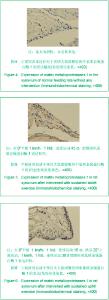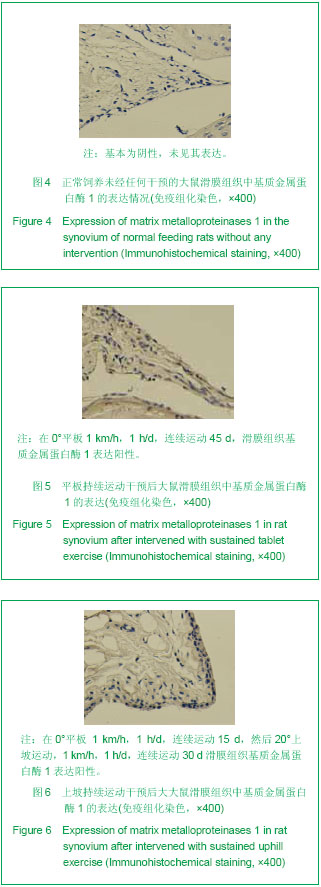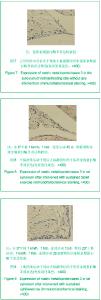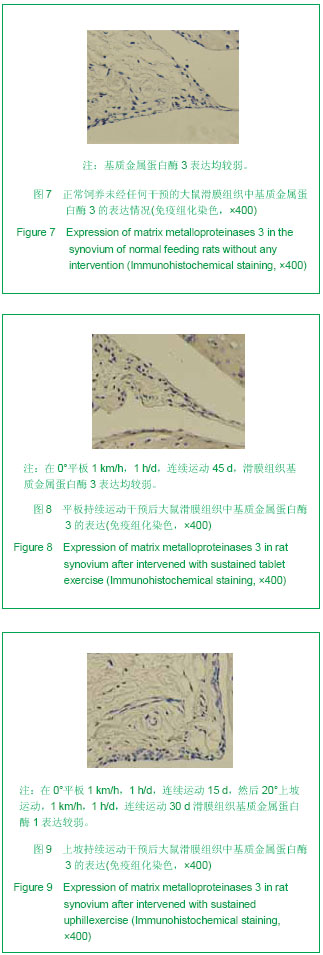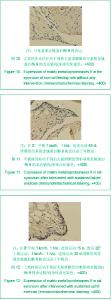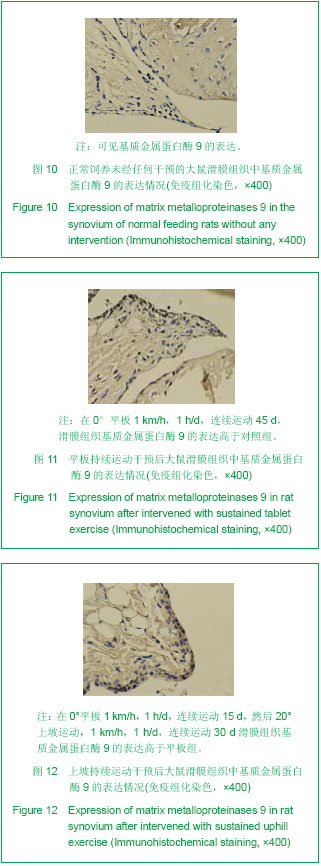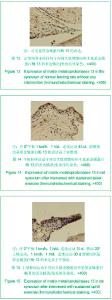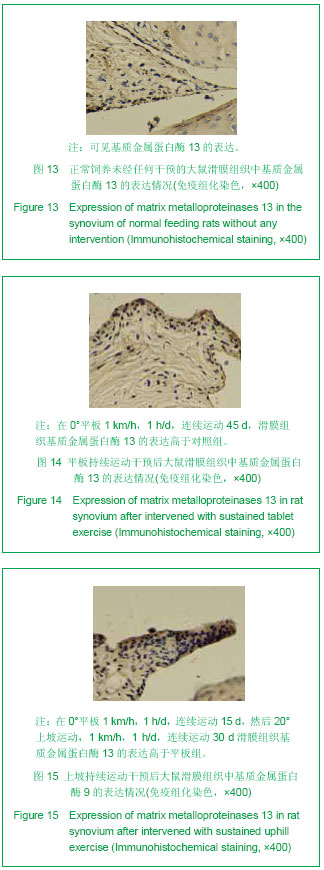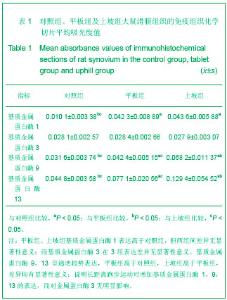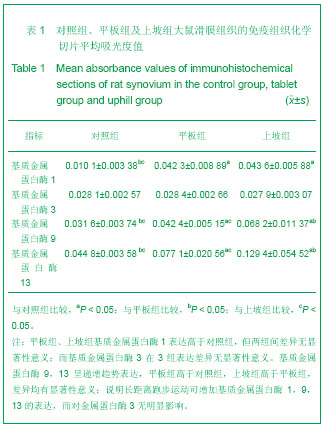Chinese Journal of Tissue Engineering Research
Previous Articles Next Articles
Expression of matrix metalloproteinases in the synovium of rat knee joint during long-distance running
Shangguan Ya-xian1, Wei Xiao-chun2, Li Kai2, Wei Jian-ping1
- 1Department of Pathology, Second Hospital of Shanxi Medical University, Taiyuan 030001, Shanxi Province, China; 2Department of Orthopedics, Second Hospital of Shanxi Medical University, Taiyuan 030001, Shanxi Province, China
-
Received:2013-03-05Revised:2013-04-27Online:2013-08-13Published:2013-08-13 -
Contact:Wei Jian-ping, Chief physician, Department of Pathology, Second Hospital of Shanxi Medical University, Taiyuan 030001, Shanxi Province, China wjp123555@sina.com -
About author:Shangguan Ya-xian★, Studying for master’s degree, Department of Pathology, Second Hospital of Shanxi Medical University, Taiyuan 030001, Shanxi Province, China lianzihuaigu@163.com -
Supported by:National Natural Science Foundation of China, No. 81000815*; Natural Science Foundation of Shanxi Province, No. 2010021034-5*; Key Scientific and Technological Planning Projects of Shanxi Province Health Department, No. 2011036*
CLC Number:
Cite this article
Shangguan Ya-xian, Wei Xiao-chun, Li Kai, Wei Jian-ping. Expression of matrix metalloproteinases in the synovium of rat knee joint during long-distance running[J]. Chinese Journal of Tissue Engineering Research, doi: 10.3969/j.issn.2095-4344.2013.33.002.
share this article
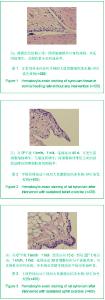
2. 1 造模过程 共使用Wistar大鼠15只,均纳入实验结果,实验过程中无死亡,标本处理中无损耗。 2.2 苏木精-伊红染色切片在显微镜下的组织学改变 对照组显示正常滑膜组织结构,滑膜细胞排列分布较规则,未见明显增生,毛细血管未见明显异常,在很多滑膜和纤维层之间的某些区域有一层疏松的结蹄组织或脂肪组织,形成一些滑膜皱褶或以“绒毛”的形式突入关节腔,见图1。而平板组和上坡组均可见滑膜的慢性炎症性表现,大量滑膜细胞增生,毛细血管增生,并伴淋巴细胞和单核巨噬细胞浸润,且多围绕血管分布,而滑膜和纤维层之间的疏松结蹄组织和脂肪组织则比对照组减少,滑膜褶皱增多,表面凹凸不平现象更常见。其中上坡组的滑膜和毛细血管增生情况比平板组更加明显,见图2,3。 2.3 免疫组织化学染色切片基质金属蛋白酶1,3,9,13的表达 基质金属蛋白酶1:在滑膜组织中,对照组的基质金属蛋白酶1表达基本为阴性,见图4;而在平板组和上坡组中,基质金属蛋白酶1均出现了阳性表达,见图5,6。经图像分析和统计,发现平板组和上坡组基质金属蛋白酶表达均明显高于对照组(P < 0.05),但两组之间差异无显著性意义(P > 0.05),见表1。"
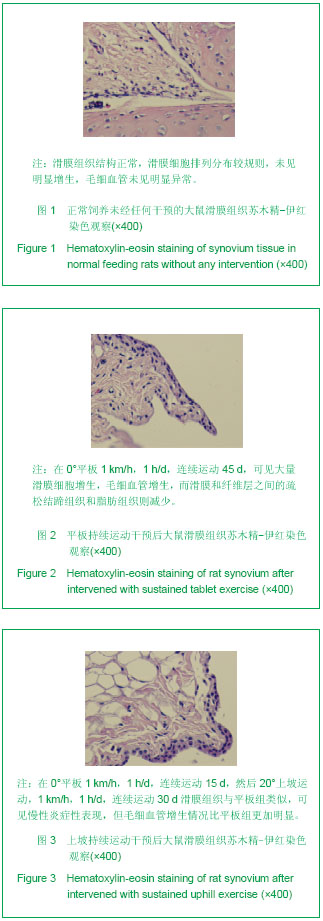
| [1] Fosang AJ, Last K, Stanton H, et al. Generation and novel distribution of matrix metalloproteinase-derived aggrecan fragments in porcine cartilage explants. J Biol Chem. 2000; 275(42):33027-33037. [2] Visse R, Nagase H.Matrix metalloproteinases and tissue inhibitors of metalloproteinases: structure, function, and biochemistry.Circ Res. 2003;92(8):827-839. [3] 王玉彬,陈安民,郭风,等.基质金属蛋白酶家族在骨关节炎软骨组织中表达的研究[J].中国矫形外科杂志,2007,t:853-855.[4] 郭静,闫冰,李琪佳,等. 骨关节炎患者关节软骨及滑膜中MMP-9、IL-6的表达[J]. 第二军医大学学报, 2011,32(6): 672-676.[5] 李石胜,吴耀持,张峻峰,等.长针透刺膝骨关节炎模型大鼠滑膜组织中基质金属蛋白酶3的变化[J]. 中国组织工程研究与临床康复,2011,15(50):9415-9418.[6] 赵敬河,杨秋云,王冰.骨关节炎时内源性细胞因子及基质金属蛋白酶抑制因子1对关节软骨的影响[J].中国组织工程研究,2012, 16(15):2665-2668.[7] Fang J, Shing Y, Wiederschain D, et al. Matrix metalloproteinase-2 is required for the switch to the angiogenic phenotype in a tumor model.Proc Natl Acad Sci U S A. 2000;97(8):3884-3889. [8] Brand K. Cancer gene therapy with tissue inhibitors of metalloproteinases (TIMPs). Curr Gene Ther. 2002;2(2): 255-271. [9] 李干,李奇,林荔军,等. IL-1、MMP-1及TIMP-1在兔骨性关节炎模型滑膜、软骨中的表达[J].实用医学杂志, 2011,27(15): 2721- 2723.[10] 高宁阳,曹月龙,刘婷, 等. C57黑鼠骨关节炎模型的关节病理积分与血清及滑膜中基质金属蛋白酶-3白细胞介素-1水平的相关性研究[J]. 中华风湿病学杂志,2010,3:195-19.[11] Haeusler G, Walter I, Helmreich M,et al. Localization of matrix metalloproteinases, (MMPs) their tissue inhibitors, and vascular endothelial growth factor (VEGF) in growth plates of children and adolescents indicates a role for MMPs in human postnatal growth and skeletal maturation. Calcif Tissue Int. 2005;76(5):326-335.[12] Henrotin Y, Addison S, Kraus V, et al. Type II collagen markers in osteoarthritis: what do they indicate?Curr Opin Rheumatol. 2007;19(5):444-450.[13] Eyre DR. Collagens and cartilage matrix homeostasis. Clin Orthop Relat Res. 2004;427:118-122. [14] Mahmoud RK, El-Ansary AK, El-Eishi HH, et al. Matrix metalloproteinases MMP-3 and MMP-1 levels in sera and synovial fluids in patients with rheumatoid arthritis and osteoarthritis. Ital J Biochem. 2005;54(3-4):248-257. [15] Green MJ, Gough AK, Devlin J, et al. Serum MMP-3 and MMP-1 and progression of joint damage in early rheumatoid arthritis. Rheumatology (Oxford). 2003;42(1):83-88. [16] Maeda S, Sawai T, Uzuki M, et al. Determination of interstitial collagenase (MMP-1) in patients with rheumatoid arthritis. Ann Rheum Dis. 1995;54(12):970-975.[17] Wu H, Du J, Zheng Q. Expression of MMP-1 in cartilage and synovium of experimentally induced rabbit ACLT traumatic osteoarthritis: immunohistochemical study. Rheumatol Int. 2008;29(1):31-36. [18] Freemont AJ, Hampson V, Tilman R, et al. Gene expression of matrix metalloproteinases 1, 3, and 9 by chondrocytes in osteoarthritic human knee articular cartilage is zone and grade specific. Ann Rheum Dis. 1997; 56(9):542-549. [19] Tolboom TC, Pieterman E, van der Laan WH, et al. Invasive properties of fibroblast-like synoviocytes: correlation with growth characteristics and expression of MMP-1, MMP-3, and MMP-10. Ann Rheum Dis. 2002;61(11):975-980.[20] Green MJ, Gough AK, Devlin J, et al. Serum MMP-3 and MMP-1 and progression of joint damage in early rheumatoid arthritis. Rheumatology (Oxford). 2003;42(1):83-88. [21] Tchetverikov I, Lard LR, DeGroot J, Matrix metalloproteinases-3, -8, -9 as markers of disease activity and joint damage progression in early rheumatoid arthritis. Ann Rheum Dis. 2003;62(11):1094-1099. [22] Hamakawa H, Takemura M, Sato M, et al. Clinical significance of MMP-3 in patients with rheumatoid arthritis: comparison with other inflammatory markers(IL-6, IL-8). Rinsho Byori. 2003;51(1):13-18. [23] Fraser A, Fearon U, Reece R, et al. Matrix metalloproteinase 9, apoptosis, and vascular morphology in early arthritis. Arthritis Rheum. 2001;44(9):2024-2028. [24] Bao JP, Chen WP, Feng J, et al. Leptin plays a catabolic role on articular cartilage. Mol Biol Rep. 2010;37(7):3265-3272. [25] Hulejová H, Baresová V, Klézl Z, et al. Increased level of cytokines and matrix metalloproteinases in osteoarthritic subchondral bone. Cytokine. 2007;38(3):151-156. [26] Hsieh YS, Yang SF, Chu SC, et al. Expression changes of gelatinases in human osteoarthritic knees and arthroscopic debridement. Arthroscopy. 2004;20(5):482-488. [27] Li H, Li L, Min J, et al. Levels of metalloproteinase (MMP-3, MMP-9), NF-kappaB ligand (RANKL), and nitric oxide (NO) in peripheral blood of osteoarthritis (OA) patients. Clin Lab. 2012; 58(7-8):755-762. [28] Liacini A, Sylvester J, Li WQ, et al. Mithramycin downregulates proinflammatory cytokine-induced matrix metalloproteinase gene expression in articular chondrocytes. Arthritis Res Ther. 2005;7(4):R777-783. [29] Takaishi H, Kimura T, Dalal S, et al. Joint diseases and matrix metalloproteinases: a role for MMP-13. Curr Pharm Biotechnol. 2008;9(1):47-54.[30] Wernicke D, Seyfert C, Hinzmann B, et al. Cloning of collagenase 3 from the synovial membrane and its expression in rheumatoid arthritis and osteoarthritis. J Rheumatol. 1996; 23(4):590-595.[31] Wernicke D, Seyfert C, Gromnica-Ihle E, et al. The expression of collagenase 3 (MMP-13) mRNA in the synovial tissue is associated with histopathologic type II synovitis in rheumatoid arthritis. Autoimmunity. 2006;39(4):307-313. [32] Reboul P, Pelletier JP, Tardif G, et al. The new collagenase, collagenase-3, is expressed and synthesized by human chondrocytes but not by synoviocytes. A role in osteoarthritis. J Clin Invest. 1996;97(9):2011-2019.[33] Fiedorczyk M, Klimiuk PA, Sierakowski S, et al. Correlations between serum matrix metalloproteinase (MMP-1, MMP-3, MMP-9, MMP-13) concentrations and markers of disease activity in early rheumatoid arthritis. Przegl Lek. 2005;62(12): 1321-1324. [34] Tang T, Muneta T, Ju YJ, et al. Serum keratan sulfate transiently increases in the early stage of osteoarthritis during strenuous running of rats: protective effect of intraarticular hyaluronan injection. Arthritis Res Ther. 2008;10(1):R13. |
| [1] | Huang Dengcheng, Wang Zhike, Cao Xuewei. Comparison of the short-term efficacy of extracorporeal shock wave therapy for middle-aged and elderly knee osteoarthritis: a meta-analysis [J]. Chinese Journal of Tissue Engineering Research, 2021, 25(9): 1471-1476. |
| [2] | Li Jing, Xie Jianshan, Cui Huilin, Cao Ximei, Yang Yanping, Li Hairong. Expression and localization of diacylglycerol kinase zeta and protein kinase C beta II in mouse back skin with different coat colors [J]. Chinese Journal of Tissue Engineering Research, 2021, 25(8): 1196-1200. |
| [3] | Huang Dengcheng, Wang Zhike, Cao Xuewei. Intravenous, topical tranexamic acid alone or their combination in total knee arthroplasty: a meta-analysis of randomized controlled trials [J]. Chinese Journal of Tissue Engineering Research, 2021, 25(6): 948-956. |
| [4] | He Xiangzhong, Chen Haiyun, Liu Jun, Lü Yang, Pan Jianke, Yang Wenbin, He Jingwen, Huang Junhan. Platelet-rich plasma combined with microfracture versus microfracture in the treatment of knee cartilage lesions: a meta-analysis [J]. Chinese Journal of Tissue Engineering Research, 2021, 25(6): 964-969. |
| [5] | Zhong Hehe, Sun Pengpeng, Sang Peng, Wu Shuhong, Liu Yi. Evaluation of knee stability after simulated reconstruction of the core ligament of the posterolateral complex [J]. Chinese Journal of Tissue Engineering Research, 2021, 25(6): 821-825. |
| [6] | Liu Shaohua, Zhou Guanming, Chen Xicong, Xiao Keming, Cai Jian, Liu Xiaofang. Influence of anterior cruciate ligament defect on the mid-term outcome of fixed-bearing unicompartmental knee arthroplasty [J]. Chinese Journal of Tissue Engineering Research, 2021, 25(6): 860-865. |
| [7] | Xie Chongxin, Zhang Lei. Comparison of knee degeneration after anterior cruciate ligament reconstruction with or without remnant preservation [J]. Chinese Journal of Tissue Engineering Research, 2021, 25(5): 735-740. |
| [8] | Li Yonghua, Feng Qiang, Tan Renting, Huang Shifu, Qiu Jinlong, Yin Heng. Molecular mechanism of Eucommia ulmoides active ingredients treating synovitis of knee osteoarthritis: an analysis based on network pharmacology [J]. Chinese Journal of Tissue Engineering Research, 2021, 25(5): 765-771. |
| [9] | Liu Xin, Yan Feihua, Hong Kunhao. Delaying cartilage degeneration by regulating the expression of aquaporins in rats with knee osteoarthritis [J]. Chinese Journal of Tissue Engineering Research, 2021, 25(5): 668-673. |
| [10] | Ma Zetao, Zeng Hui, Wang Deli, Weng Jian, Feng Song. MicroRNA-138-5p regulates chondrocyte proliferation and autophagy [J]. Chinese Journal of Tissue Engineering Research, 2021, 25(5): 674-678. |
| [11] | Wang Weigang, Yang Zhidong, Feng Zongquan, Wang Ding. A mid-term clinical follow-up of unicompartmental knee arthroplasty with fixed bearing [J]. Chinese Journal of Tissue Engineering Research, 2021, 25(3): 368-373. |
| [12] | Wang Xiaofei, Teng Xueren, Cong Linyan, Zhou Xu, Ma Zhenhua. Herbert screw internal fixation for treating adult osteochondritis dissecans of the knees [J]. Chinese Journal of Tissue Engineering Research, 2021, 25(3): 397-402. |
| [13] | Luo Anyu, Liu Hanlin, Xie Xiaofei, Huang Chen. Effect of antioxidant mixture on structural degeneration of an osteoarthritis rat model [J]. Chinese Journal of Tissue Engineering Research, 2021, 25(23): 3625-3629. |
| [14] | Yang Caihui, Liu Qicheng, Dong Ming, Wang Lina, Zuo Meina, Lu Ying, Niu Weidong. Serine/threonine protein kinases can promote bone destruction in mouse models of chronic periapical periodontitis [J]. Chinese Journal of Tissue Engineering Research, 2021, 25(23): 3654-3659. |
| [15] | Yan Peng, Ma Yufei, Cui Jingfu, Hao Shaofei, Liu Jinhui, Guan Chunlei, Wang Xiaoran, Yang Xiaoyu. Mechanism of anodic block electrical stimulation of sacral nerve root to reconstruct bladder function [J]. Chinese Journal of Tissue Engineering Research, 2021, 25(23): 3684-3689. |
| Viewed | ||||||
|
Full text |
|
|||||
|
Abstract |
|
|||||
